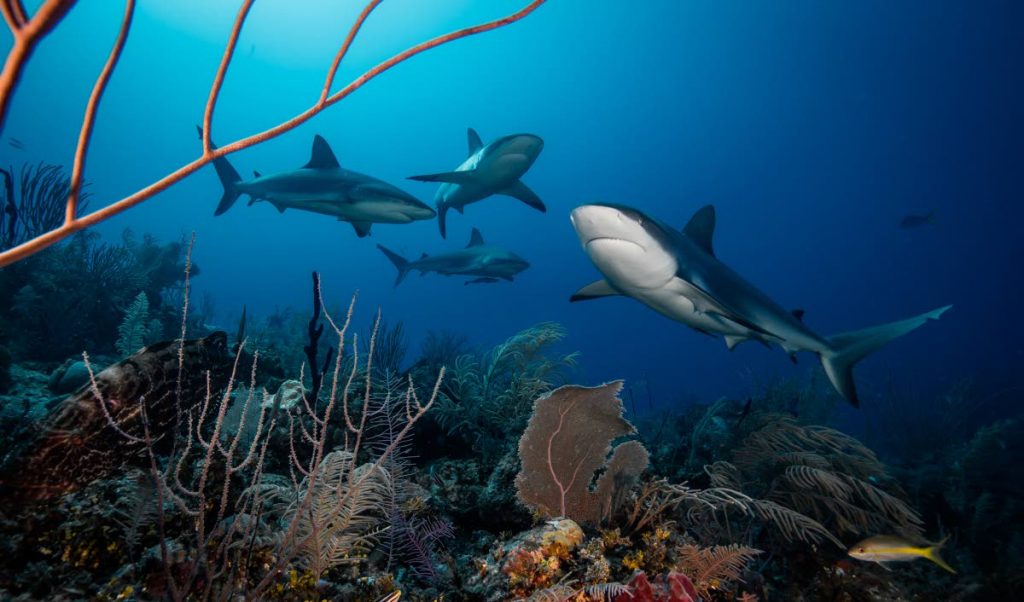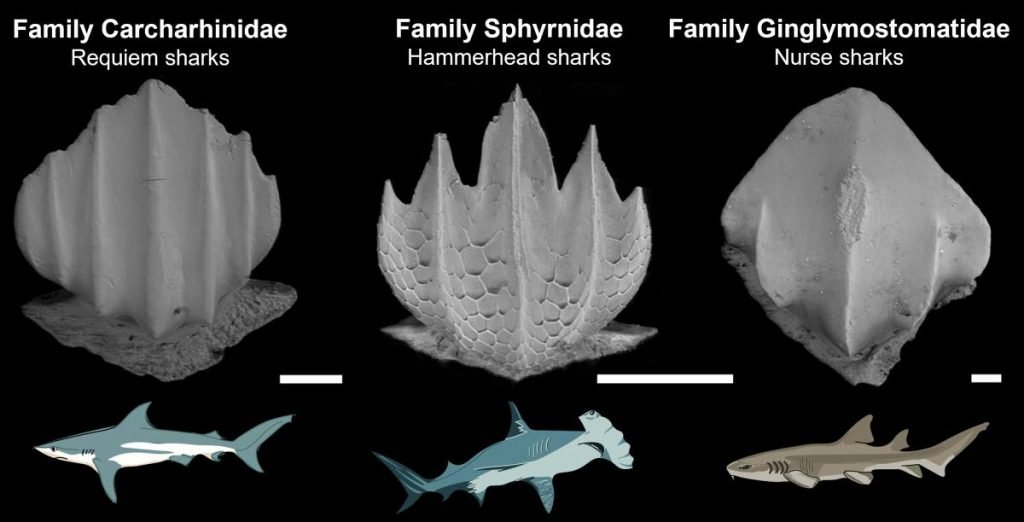Disappearing sharks

A kind of underwater archaeology is telling us how important sharks were to healthy reefs. Dr Anjani Ganase looks at a recent study based on shark scales collected in the sediment on coral reefs.
In my 15 years of diving on reefs of Tobago and the Caribbean, I can count the number of sharks I’ve encountered on one hand. This is a tragic reflection of the impact of mismanaged fishing pressures. Over decades we have decimated the shark communities regionally. This decline is also an alarming trend in other parts of the world. Even on reefs with a management system, sharks are declining because of loss of reef habitat and the ravages of climate change. In 2012, when I first surveyed the far-northern reefs of the Great Barrier Reef (GBR) in Australia, our team encountered dozens of reef sharks on every reef we visited. Four years later, after two major bleaching events hit the GBR, we were lucky to encounter a single shark.
When such decimation happens so rapidly it is hard for scientists in the marine research field to imagine what shark-populated reefs look like. Yet, an understanding of sharks on reef ecosystems is necessary to fathom the impact of human activities, and scientists have to undertake a kind of archaeology to appreciate the full scope of healthy ocean ecosystems.
Shifting baselines refer to the way we measure how much a system has changed based on our first experience or reference point with the system. When I learned to dive, most of the branching corals in the Caribbean were wiped out by disease, and the only sharks I encountered on the reefs were nurse sharks.

-
Scientist Erin Dillon and her team at her lab at the University of California, Santa Barbara worked out a simple and ingenious method to reconstruct what shark communities in the Caribbean may have looked like before modern day developments (over 6,000 years ago). To date most of the information about sharks might be found in ships logs. Searching for shark fossils is difficult as they are incredibly rare. Both these methods only provide glimpses into the communities and the diversity of shark species that existed.
Shark dandruff
In her study, Dillon uses a method based on collecting shark dermal denticles that have been shed from shark’s skin and settled in the sediment of coral reefs, or as she likes to refer to it, shark dandruff. You may be wondering what dermal denticles are. Literally translated they are “skin teeth.” The skin of sharks is covered in microscopic tooth-like scales made up of the same material as their teeth. Like the fibreglass of a boat, the denticles are lightweight but extremely tough. Dermal denticles vary from place to place on a shark’s body and differ among sharks. They have multiple functions for sharks and the morphology (shape, size and structure) of the denticle gives light to the specific roles they play.
By creating a reference collection for the different denticles discovered on the reefs, Dillon found that the shape of the denticles was less associated to a species of shark, but more reflected the ecological roles of the sharks. She found five main functions of the denticles: drag reduction; defence; abrasion; luminescence; and more general functions. For each of these roles, the denticle would have defining traits. For example, in certain sharks, the denticles along the body of the shark assists in drag reduction as the shark swims.
If you ever touched the skin of these sharks, you would notice that if you run your fingers from front to back, it’ll feel extremely smooth and slippery. But if you run your hand in the opposite direction, the skin feels like sandpaper. This type of denticle is common on the fast-swimming pelagic (open sea) sharks. This includes the family of requiem sharks which is a family of sharks (family Carcharhinidae) commonly found in warm seas and which migrate large distances. Among these are tiger sharks, bull sharks, and black tip reef sharks. Conversely, for demersal sharks that reside close to the bottom of the reefs and sandy areas, such as nurse sharks, the denticles found on their bodies do more to protect against abrasion from surfaces.
To reconstruct ancient shark communities, Dillon collected samples from an ancient reef (dated to 7,000 years old) revealed during a construction site in Panama. She also took samples from a modern reef system. From the denticles collected in the reef sediment the team was able to reconstruct and compare the shark communities now with communities that existed before the modern era. It was found that the accumulation of denticles on the ancient reef were consistently three times the amount found on modern-day reefs across all the different types of denticle functional groups.
The reductions in the amount of denticles was most apparent in the denticles representing commercially caught sharks. These were largely made up of the requiem sharks, ranging from apex sharks such as tiger and bull sharks, as well as medium-sized reef sharks such as the black tips and grey reef sharks. The research team was also able to identify that the drastic decline in the local shark community took place around the mid 1900s, with the advent of shark fisheries in Panama. I suspect that we may also find a similar distinct pattern in our reef sediment for TT and even the wider Caribbean. Sharks have been largely fished out throughout the region.
Cultivating sharks and their habitats

-
Interestingly, Dillon also observed reductions in denticles related to sharks that were not targeted for harvesting, such as nurse sharks, which can still be found on coral reefs. She related this decline to human disturbances that indirectly resulted in the loss of the shark’s food and habitat. By recognising the true baseline of shark communities, we can confront how much humans have changed our oceans and make a sincere effort to return the system as close as possible to a healthy system.
Sharks are crucial for coral reefs and have played a pivotal role in regulating the food webs of complex ecosystems adapted over thousands of years. Yet we have managed to remove the majority of these populations in less than 100 years (70 per cent loss since the 1970s). We need to rethink our relationships with sharks for the sake of our ecological health, from which we derive our well-being and our economy. We urgently need to change our culture of shark-eating to one of shark-conservation. Because while we believe “shark and bake is we culture,” the reality is that cultures either adapt or die.


Comments
"Disappearing sharks"